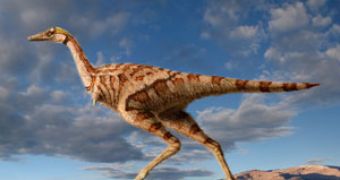The first dinosaur species with only one finger to be discovered, has been found in Inner Mongolia, China, by an international team of palaeontologists, and has been named Linhenykus monodactylus, after the nearby city of Linhe.
It belongs to the branch of Alvarezsauroidea, part of the carnivorous dinosaur group Theropoda, who gave birth to modern birds and include the Tyrannosaurs Rex and the Velociraptor.
The fossil was preserved in rocks of the Upper Cretaceous Wulansuhai Formation, located near the border between Mongolia and China, dated to 84-75 million years ago.
The formation has revealed many vertebrate fossils, like the recently discovered Linheraptor exquisitus, in 2010.
Researchers uncovered a partial skeleton, including bones of the vertebral column, the forelimb, a partial pelvis and almost complete hind limbs.
This dinosaur probably grew a couple of feet tall and weighed no more than a large parrot, but what's unusual about it is the one claw on each of its hands, that could have been used to dig into insect nests.
This specimen is actually the only known dinosaur with one finger, and this confirms the variety of evolutionary changes of the hand, which existed in different theropods.
Michael Pittman of the Department of Earth Sciences at University College London, co-author and discoverer of the specimen explains the fingers evolution:
“Non-avian theropods start with five fingers but evolved to have only three fingers in later forms.
“Tyrannosaurs were unusual in having just two fingers but the one-fingered Linhenykus shows how extensive and complex theropod hand modifications really were.”
So, most theropod dinosaurs have three fingers on each hand, but in most alvarezsauroids other than Linhenykus the two outer fingers are reduced to very small and apparently useless structures.
The fact that the Linhenykus has only one finger, and since it is believed that this dinosaur was a relatively primitive alvarezsauroid, leads to conclude that not all members of the group had the vestigial fingers.
It is uncertain why the Linhenykus lost the other two fingers, but the reason could be a very simple matter of natural selection.
“Vestigial structures, like legs in whales and snakes, may appear and disappear seemingly randomly in the course of evolution,” said Jonah Choiniere, co-author and co-discoverer of the specimen from the Division of Paleontology at the American Museum of Natural History.
“Linhenykus highlights the vestigiality of the outer fingers of advanced alvarezsauroids and underscores the complexity in evolution of these vestigial fingers.”
Linhenykus lived with other similar theropod dinosaurs, but the specificity of its skeleton could reflect differences in behavior or foraging strategy.
It also lived alongside small mammals, lizards, clubbed dinosaurs (ankylosaurs) and horned dinosaurs (ceratopsians).
This discovery is published online in Proceedings of the National Academy of Sciences (PNAS).

 14 DAY TRIAL //
14 DAY TRIAL //